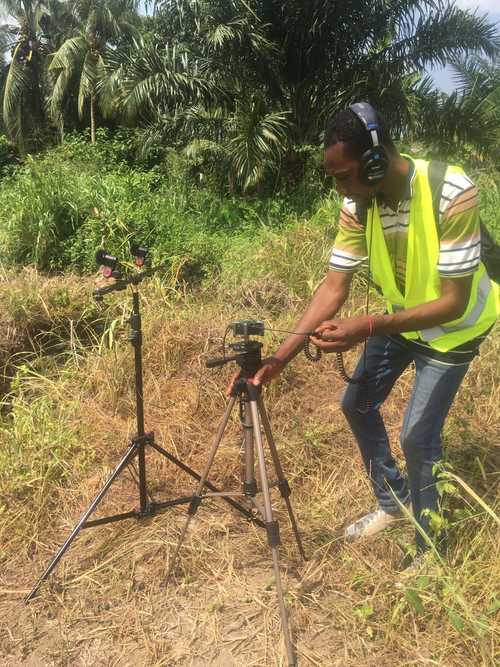
Emmanuel Baffoe: My soundscape ecology journey
My journey in soundscape ecology started when I was informed by Samuel Kudjodzi, a Germany-based acoustic ecologist and multimedia specialist, of a training program geared towards elevating young people and young adults in this field.
Hitherto, I was very curious about the complex field recording equipment Samuel brought to Ghana when he visited in 2021 and 2022. He explained that it was for recording diverse ecosystems for immersive installation works about fragile ecosystems.
His main location was a degraded wetland settlement he was monitoring for hours upon hours and at different times of the day and night. He explained the sequence of the final installation project:
a. Explanation of habitats
b. Highlighting both the health and stresses of the selected habitat and its effect on the humans living in and around the communities
c. Elaborating the ecological functions of the species within the habitats
d. Elaborating the complexities and meanings of the species’ communication
e. A profile of all found species with fascinating macro photographs.
I found this very impactful, so I was elated to hear that, if I was interested, I would be selected as first trainer and national coordinator of the Centre for Soundscape Ecology and Multimedia (CSEM). This good news triggered past memories and experiences with sound technologies and detailed listening.
Samuel later informed me, in June 2023, that Earth.fm had granted a full set of field recording equipment for the project, and that he would be coming to Ghana for the training program. Several attempts in 2023 failed, but between October and November 2024 he personally mentored me in the following areas: stereo field monitoring (the movement of objects in space), focused and peripheral listening, how omni-directional microphones work, balanced placement of microphones, handling of field recorders and batteries, listening with amplification, and closed-back/open-back reference headphones and how they work.
Seeing my first set of equipment and knowing I have it any time I need it made me feel joyful and assured. I was also shown a complex list of topics in a structured curriculum which will be carried out in due course.
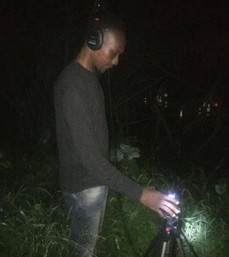
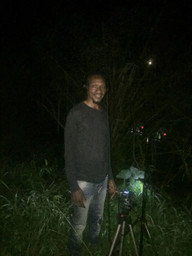
Together, Samuel and I made some field recordings of a night ambience and of a bat species which was vocalising in multiple frequency ranges (and later published the work on the Radio Aporee platform). Listening in real time via the Sony MDR-7506 reference headphone, I was wowed by the vast stereo-space and exclaimed to Samuel about the microphones’ sensitivity and the power of the Zoom F3 Field Recorder.
That experience fuelled my enthusiasm and curiosity, so, the following night, I visited a pond in my community and recorded two peculiar frog species whose calls stood out in the soundscape. I was mesmerized and fascinated, and, for educational purposes, am researching their names and the names of all other frog species heard in the recording.
Out of excitement, I continued my practice by recording a rushing stream at night, which has been available on Earth.fm since December 2024. I’m grateful for this international exposure.
Part of my mentorship program is an information-sharing platform created by Samuel, which includes a great amount of material about ecology, bioacoustics, and acoustic engineering, links to information on selected project sites, references to pioneers in soundscape ecology, such as Bernie Krause and David Monacchi – plus, regular updates about meetings with resource people.
In December 2024, directed by Samuel, I started a new mentorship session by carrying out amplified listening exercises with Abigail Baffoe. It was fulfilling to know that I could share knowledge with someone who will be in a good position to share it with other selected candidates.
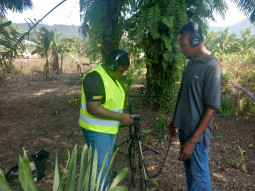
This is how Samuel intended the program to work, so I was very happy to spearhead it. I will embark on diverse field recordings in selected ecosystems for publication on Earth.fm.
In a mentorship session, I was told that recordings for Earth.fm are to avoid man-made (anthropogenic) noise. This was my first time hearing such a word, and it made me reflective. I later realised that anthropogenic noise greatly masks and interferes with the quiet, symphonic nighttime-ambience recordings of wildlife which I have made in several suburban communities. Sometimes, I get irritated that such beautiful recordings are marred by the engines of vehicles or loud church and pub music. I also learned that these noises even affect the breeding patterns of wild species, which makes me very sad.
Elsewhere, I have recorded degraded wetland sites in Koforidua, to add to CSEM’s existing binaural archives of material gathered between 2021 and 2022. These will be used in the aforementioned immersive installation on wetlands and their effect on biodiversity and human life. In addition to the recordings are eye-witness interviews I have conducted about the wetland area and how it has changed over the years, in terms of species, vegetation, and weather patterns.
Samuel’s wealth of knowledge and deep research skills have had a very positive impact on my confidence levels, and my work has put me in contact with highly resourceful locals. I have been approached in several recording situations by locals who appreciated what I was doing and gave assistance, one way or another. Samuel also advises taking GPS-tagged photographs of locations and keeping an aural diary (including time, place, and weather) before pressing the record button. I sometimes forget this, due to my haste and excitement about the subjects I’m hearing and want to record, but I am learning to normalise it.
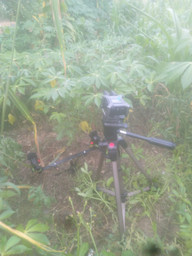
Recently, I have planned a field recording project in pristine and critically endangered ecosystems for educational and outreach programs, and for publication on Earth.fm. I have selected all six Ramsar sites in Ghana and two forest reserves: the Atewa Range Forest Reserve and the Bobiri Butterfly Sanctuary, which are home to rich biodiversity. According to the Convention on Wetlands [an international conservation treaty], these ecosystems are critical to the survival of the diverse and endangered species which occur there, but are at risk from mining and human settlement and encroachment. I am kindly appealing for support in this mammoth task, so that together we can help to make our world a better place.
In conclusion, soundscape ecology has taught me a lot about nature and the way that human survival is tied to it. For this reason, I am eager to share a lot to the public, both local and international, through sound installations, book publications, conferences, workshops, interviews and talks, in the near future. I am also open to collaborations with researchers, conservation-themed organisations, artists, creatives, philanthropists, sponsors, etc, both local and abroad.
Featured photo: Emmanuel doing daytime field recording in a degraded wetland.
All photos courtesy of Samuel Kudjodzi, Emmanuel Baffoe, Abigail Baffoe
Earth.fm is a completely free streaming service of 1000+ nature sounds from around the world, offering natural soundscapes and guided meditations for people who wish to listen to nature, relax, and become more connected. Launched in 2022, Earth.fm is a non-profit and a 1% for the Planet Environmental Partner.
Check out our recordings of nature ambience from sound recordists and artists spanning the globe, our thematic playlists of immersive soundscapes and our Wind Is the Original Radio podcast.
You can join the Earth.fm family by signing up for our newsletter of weekly inspiration for your precious ears, or become a member to enjoy the extra Earth.fm features and goodies and support us on our mission.
Subscription fees contribute to growing our library of authentic nature sounds, research into topics like noise pollution and the connection between nature and mental wellbeing, as well as funding grants that support emerging nature sound recordists from underprivileged communities.
